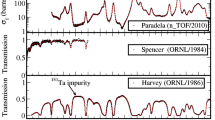Abstract
The spatial distribution of DNA double-strand breaks (DSB) was assessed after treatment of mammalian cells (V79) with densely ionizing radiation. Cells were exposed to beams of heavy charged particles (calcium ions: 6.9 MeV/u, 2.1⋅103 keV/μm; uranium ions: 9.0 MeV/u, 1.4⋅104 keV/μm) at the linear accelerator UNILAC of GSI, Darmstadt. DNA was isolated in agarose plugs and subjected to pulsed-field gel electrophoresis under conditions that separated DNA fragments of size 50 kbp to 5 Mbp. The measured fragment distributions were compared to those obtained after γ-irradiation and were analyzed by means of a convolution and a deconvolution technique. In contrast to the finding for γ-radiation, the distributions produced by heavy ions do not correspond to the random breakage model. Their marked overdispersion and the observed excess of short fragments reflect spatial clustering of DSB that extends over large regions of the DNA, up to several mega base pairs (Mbp). At fluences of 0.75 and 1.5/μm2, calcium ions produce nearly the same shape of fragment spectrum, merely with a difference in the amount of DNA entering the gel; this suggests that the DNA is fragmented by individual calcium ions. At a fluence of 0.8/μm2 uranium ions produce a profile that is shifted to smaller fragment sizes in comparison to the profile obtained at a fluence of 0.4/μm2; this suggests cumulative action of two separate ions in the formation of fragments. These observations are not consistent with the expectation that the uranium ions, with their much larger LET, should be more likely to produce single particle action than the calcium ions. However, a consideration of the greater lateral extension of the tracks of the faster uranium ions explains the observed differences; it suggests that the DNA is closely coiled so that even DNA locations several Mbp apart are usually not separated by less than 0.1 or 0.2 μm.
Similar content being viewed by others
Author information
Authors and Affiliations
Additional information
Received: 27 January 1998 / Accepted in revised form: 15 April 1998
Rights and permissions
About this article
Cite this article
Kraxenberger, F., Weber, K., Friedl, A. et al. DNA double-strand breaks in mammalian cells exposed to Á-rays and very heavy ions . Radiat Environ Biophys 37, 107–115 (1998). https://doi.org/10.1007/s004110050102
Issue Date:
DOI: https://doi.org/10.1007/s004110050102




